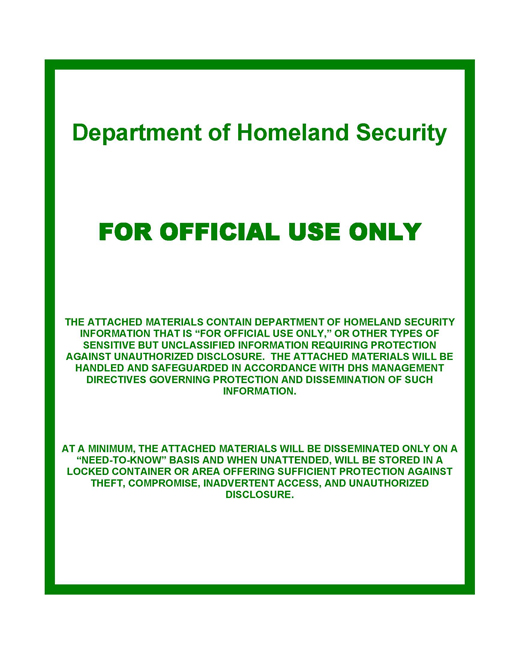Top Officials Exercise 3 (T3)
- 19 pages
- For Official Use Only
- UK Restricted
- Protected Other Government
- January 12, 2005
1. Executive Summary
T3 provides private sector organizations and associations with an opportunity to test their emergency response and business continuity plans in conjunction with Federal, State, and local response agencies. As the largest national Full-Scale Exercise (FSE) in history, last year’s TOPOFF 2 exercise engaged more than 8,500 participants. With private sector participation, T3 promises to be larger in scope and complexity. Private sector organizations are offered the following range of opportunities for participation:
• Tabletop Exercise (TTX): notional, internal participation by an organization’s emergency response experts through one-way information exchange by phone, email, and Internet, or two-way information exchange within a private sector association, the National Infrastructure Coordinating Center, or the Private Sector Office chair in the Interagency Incident Management Group.
• Command Post Exercise (CPX): activation of emergency operations center (EOC) plan at organization site without implementing emergency response actions. Two-way information exchange is allowed with all other participating private sector relevant players.
• Full-Scale Exercise (FSE): actual emergency response center activation and implementation of emergency response plan activities. May include tactical field operations. Two-way information exchange is allowed with all other participating private sector relevant players. The T3 scenario engages private sector participants from perspectives of critical and non-critical infrastructure sectors and includes nonprofit volunteers and donations management organizations. Reponses are coordinated in accordance with State and local emergency response plans as well as the following new national response plan (NRP) support annexes:
• Private Sector Support Annex
• Volunteer and Donations Management Support AnnexT3 will be conducted from April 4–8, 2005, and includes the following venues and events:
• Connecticut: chemical attack and an explosive device
• New Jersey: biological attack
• Washington, D.C.
• United Kingdom and CanadaHours of play during this period can range from a few hours, to a full business day, to a maximum of 12 hours of play per day from 0800–2000 hours. Private sector organizations may decide how many individuals will “play” and to what extent. Players will receive information from multiple sources, including a virtual news network that will replicate the cable news sources that would be available in an actual response. Players participating in the CPX or FSE modes will contact other participant players and respond just as they would in a real incident. Longer-term transition and recovery operations will be addressed during a related follow-on Large-Scale Game (LSG) to be conducted on May 3-5, 2005. Mobilization and approval of private sector players within the venues must be coordinated with State exercise planning teams to ensure functional integration.
…
2. Private Sector Interface Points
The following FSL departments and agencies (D/As) and private sector associations and organizations are listed as potential private sector interface points to be exercised during T3.
2.1 Federal
• DHS Private Sector Office (PSO)
• DHS Infrastructure Coordination Division (ICD)
o National Infrastructure Coordinating Center (NICC)
o Infrastructure Coordination and Analysis Office Sector Specialists (ICD/ICAO)
o Protected Critical Infrastructure Information Office
o Infrastructure Programs Office
• DHS Federal Emergency Management Agency (FEMA)
• DHS Citizens Corps
• Joint Field Office (JFO)2.2 State and local
• State Emergency Operations Center (EOC)
• Local EOC2.3 Private sector associations and networks
• Critical Infrastructure and Key Resource (CI/KR) sector organizations and Sector Coordinating Councils (SCCs), Government Coordinating Councils (GCCs), and Information Sharing and Analysis Centers (ISACs)—private sector self-organized centers to share critical infrastructure, strategic, and operational information
• National and regional associations and organizations2.4 Private sector individual organizations
• Corporations
• Nongovernmental organizations
• Faith-based groups3. Objectives for Private Sector Integration
3.1 Private Sector Perspective
The following objectives have been proposed by the private sector for participation in T3:
• Examine private sector emergency response and business continuity plans.
• Exercise communications links with relevant government agencies.
• Improve information-sharing processes and capabilities.
• Test Protective Critical Infrastructure Information program.
• Gain and maintain situational awareness of an emerging event.…
4. Private Sector Integration Assumptions
4.1 Impacted Sectors
The national private sector working group plans to test at least three critical infrastructure (CI) sectors in T3. The DHS Infrastructure Coordination Division will recommend impacted sectors for participation at the national level. The State exercise planning teams will determine State-level participation. The following sectors are being considered, although participation beyond these sectors is possible:
• Transportation: truck, rail, marine
• Chemical/HAZMAT
• Real estate/commercial
• Energy: oil, gas
• Water
• Public healthMany current national and local private sector planning group members represent critical infrastructure and volunteer and donations management associations and networks. These network participants, along with individual participating organizations, will mobilize organizations and companies for exercise participation. All local venue participant companies and organizations should be identified and registered by January 21, 2005. Registration requires submittal, acceptance, and approval of a player fact sheet (see attached).

